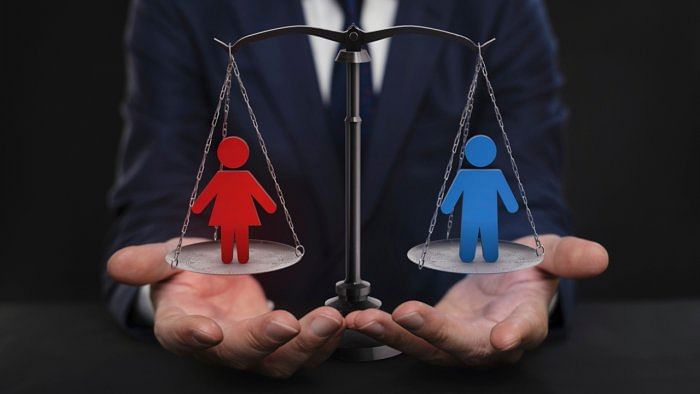
Despite notable progress in closing the gender pay gap over time in India, the gap remains high by international standards.
Credit: iStock Images
Over the last four decades, India has seen low levels of women’s labour force participation, with gaps of nearly 40 per cent between the proportions of men and women in the labour force. Covid-19-induced lock-downs had a significant impact on the global economy. It greatly affected the labour market, with many businesses implementing pay freezes and rising unemployment, economic inactivity, and redundancies.
One of the main consequences is exacerbating pre-existing inequalities, particularly those related to gender. Women’s employment has suffered disproportionately, resulting in women being furloughed or losing their jobs, especially those who work in sectors hit hardest by the economic downturn.
The World Economic Forum (WEF) recently ranked India at 135 out of 146 countries in its Global Gender Gap (GGG) Index for 2022. According to the World Inequality Report 2022 estimates, men earn 82 per cent of the labour income in India, whereas women earn 18 per cent.
The long-term economic and social consequences of this can be severe. With the widening of inequality, there is an urgent need for further research to understand the extent of the issue and identify potential solutions to reverse the impact of gender pay parity.
Covid-19 and women’s jobs
The lock-downs immediately impacted women, with 37.1 per cent losing jobs (compared to 27.7 per cent for men) between April 2020 and April 2021, as per data from the Centre for Monitoring Indian Economy (CMIE). It has been observed that women’s employment recovery has been slower. With the increased load of unpaid household work, women struggle to find time for office work between household chores and care-giving responsibilities, leading to increased stress and eventually quitting paid work.
As per the data from CMIE, even in January 2022, women’s labour force participation was 9.4 per cent lower than in January 2020, compared to 1.6 per cent for men. The number of employed rural women experienced a steep initial dip, from 29.8 million in March 2020 to 17.8 million in April 2020, by 40.2 per cent versus 25.5 per cent for rural men. On the other hand, urban female employment fell from 11.8 million in March 2020 to 8.3 million in April 2020, that is, by 29.2 per cent, versus 32.4 per cent for men.
During the pandemic, gender pay disparities in technology, healthcare, and financial services have significantly widened, compounding existing inequities in these industries.
Analysis of gender pay gaps
Despite notable progress in closing the gender pay gap over time in India, the gap remains high by international standards. As per the labour force survey data of the National Sample Survey Office (NSSO), Indian women earned, on average, 48 per cent less than their male counterparts in 1993-94. Since then, the gap has declined to 28 per cent in 2018-19.
The pandemic reversed decades of progress, as preliminary estimates from the Periodic Labour Force Survey (PLFS) 2020-21 show an increase in the gap by 7 per cent between 2018-19 and 2020-21. The data further suggests that a faster decline in female wages during the pandemic contributed to this decline, contrasted with a faster growth in male wages.
The International Labour Organization (ILO) estimates that women, on average, continue to be paid about 20 per cent less than men worldwide.
This data highlights a significant disparity in salary growth and career progression between genders, which can have long-term consequences for women’s financial stability and economic independence. These findings underscore the need for continued efforts to address gender inequality in the workplace and ensure that women have equal opportunities for career advancement and fair compensation.
According to a report by the World Economic Forum (2022), in India, the share of women legislators, senior officials, and managers increased from 14.6 per cent to 17.6 per cent, and the share of women as professional and technical workers grew from 29.2 per cent to 32.9 per cent. The gender parity score for estimated earned income has improved.
Underlying reasons
In India, women are predominantly in the informal sector and choose home-based employment options that allow them to balance domestic duties. The reasons are the prevailing sociocultural factors, including the increased burden of unpaid domestic work, exacerbated gender-based skill and educational gaps, digital illiteracy, mobility restrictions, and the lack of institutional support at workplaces.
Women are often paid less than men for the same job and marginalised in leadership roles which offer greater compensation and job security. The gender pay gap has persisted in finance and insurance consulting, healthcare, and transportation industries.
Expected policy changes
Gender pay gaps are not just an issue of fairness but also have economic implications. A report by the Mc Kinsey Global Institute found that closing gender pay gaps could add $12 trillion to global GDP by 2025.
Steps that businesses and policymakers can take to address the problem include
Implementing equal pay policies
Promoting flexible working arrangements
Providing training and development opportunities for women.
By taking proactive steps to address gender pay gaps, businesses and policymakers can help create more equitable workplaces. Governments can provide support through gender-sensitive job-creation plans to expand women’s employment in the public and micro, small, and medium enterprise sectors and incentivise women’s entrepreneurship.
Additionally, investing in women’s resources and upskilling them for leadership roles can help bridge the gender gap in higher-paying positions. Organisations can create a more diverse and inclusive workforce by empowering women to advance in their careers.
(The author is the CEO of a human resource firm)